Adventures in Historical Linguistics
While linguistics do not cut the same kind of glamorous profile in fiction as, say, international espionage or organized crime, it does pop up now and again. Even historical linguistics. Having stumbled across a couple older examples recently (thus, historical fictional historical linguistics), I commend them to our readers as an alternative to the cheap thrills that might otherwise tempt them.
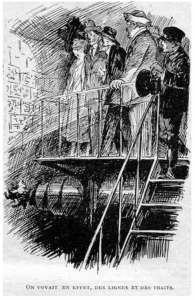 Leon Groc’s Le deux mille ans sous la mer (‘2000 years under the sea’), from 1924, starts out with our heroes supervising the construction of a tunnel under the English Channel. They discover a mysterious inscription on a rock face. Fortunately, one of the party is a philologist, and identifies it as Chaldean (i.e. a form of Aramaic)! And a particularly archaic variety at that. This impresses the rest of the party, at least as much as the content of the inscription itself: Impious invaders, you shall not go any further. However, a subsequent mining accident forces them to break through the rock, where they discover a cavern inhabited by race of pale blind people, descendants of Chaldeans (or to be more precise, speakers of Chaldean) who had sought refuge in that cavern from some long-forgotten disaster, only to discover they couldn’t find a way out. The learned philologist applies his practical knowledge of Chaldean in communicating them. I won’t spoil the fun for those of you planning to read it; but it does not go well.
Leon Groc’s Le deux mille ans sous la mer (‘2000 years under the sea’), from 1924, starts out with our heroes supervising the construction of a tunnel under the English Channel. They discover a mysterious inscription on a rock face. Fortunately, one of the party is a philologist, and identifies it as Chaldean (i.e. a form of Aramaic)! And a particularly archaic variety at that. This impresses the rest of the party, at least as much as the content of the inscription itself: Impious invaders, you shall not go any further. However, a subsequent mining accident forces them to break through the rock, where they discover a cavern inhabited by race of pale blind people, descendants of Chaldeans (or to be more precise, speakers of Chaldean) who had sought refuge in that cavern from some long-forgotten disaster, only to discover they couldn’t find a way out. The learned philologist applies his practical knowledge of Chaldean in communicating them. I won’t spoil the fun for those of you planning to read it; but it does not go well.
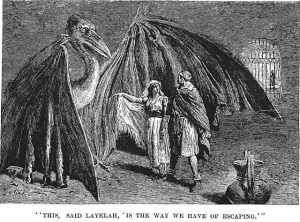 James De Mille’s A Strange Manuscript Found in a Copper Cylinder from 1888 features members of a British expedition surveying the South Pacific becoming stranded in an unknown country with – once again – some cave dwellers, who call themselves Kosekin and speak a Semitic language. In the usual fashion of such stories in this period, there is a narrative within a narrative, in this case the manuscript directly relating the adventure, and the commentary of the members of the yacht party who discovered it. While the core narrator (named More) merely recognizes some affinity to Arabic, one of the members of the yacht party just so happens – once again – to have a philological background, which, after a lengthy digression on the comparative method and Grimm’s law, leads him to conclude that the underground race speaks a language descended from Hebrew:
James De Mille’s A Strange Manuscript Found in a Copper Cylinder from 1888 features members of a British expedition surveying the South Pacific becoming stranded in an unknown country with – once again – some cave dwellers, who call themselves Kosekin and speak a Semitic language. In the usual fashion of such stories in this period, there is a narrative within a narrative, in this case the manuscript directly relating the adventure, and the commentary of the members of the yacht party who discovered it. While the core narrator (named More) merely recognizes some affinity to Arabic, one of the members of the yacht party just so happens – once again – to have a philological background, which, after a lengthy digression on the comparative method and Grimm’s law, leads him to conclude that the underground race speaks a language descended from Hebrew:
I can give you word after word that More has mentioned which corresponds to a kindred Hebrew word in accordance with ‘Grimm’s Law.’ For instance, Kosekin ‘Op,’ Hebrew ‘Oph;’ Kosekin ‘Athon,’ Hebrew ‘Adon;’ Kosekin ‘Salon,’ Hebrew ‘Shalom.’ They are more like Hebrew than Arabic, just as Anglo-Saxon words are more like Latin or Greek than Sanscrit.
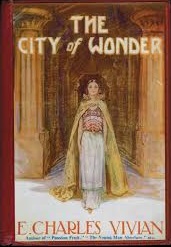 Further proof of the power of historical linguistics in a tight situation comes from E. Charles Vivian’s City of Wonder (1923). Again in the South Pacific, a group of adventurers is attacked by a strange woman (speaking, of course, a strange language) in charge of a monkey army. Taking stock after having slaughtered the attackers, the narrator asks one of his companions:
Further proof of the power of historical linguistics in a tight situation comes from E. Charles Vivian’s City of Wonder (1923). Again in the South Pacific, a group of adventurers is attacked by a strange woman (speaking, of course, a strange language) in charge of a monkey army. Taking stock after having slaughtered the attackers, the narrator asks one of his companions:
“What is the language she used?” I asked.
“The nearest I can tell you, so far, is that it’s a sort of bastard Persian,” he answered. “It’s a dialect built on a Sanskrit foundation—in my youth I studied Sanskrit, for it’s the key to every Aryan language or dialect in the East, and I always meant to come East. I must stuff you two.”
“Stuff us?” Bent asked.
“Fill you up with words that will be useful—it’s astonishing what you can do in a language if you know three or four hundred words in common use. If you hear it and have to make yourself understood in it, the construction of sentences very soon comes to you. That is, if the language is built on an Aryan foundation, as this is.”
It’s that easy! You just need to learn the method.
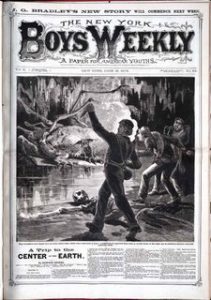 Back underground, Howard De Vere’s A Trip to the Center of the Earth, first published in New York Boys’ Weekly in 1878, is a story I haven’t been able to track it down yet, but from the description in E.F. Bleiler’s Science Fiction: The Early Years, it promises to be one of the high points in early dime novel treatments of historical linguistics. A pair of boys exploring Kentucky’s Mammoth Cave come across an underground world where
Back underground, Howard De Vere’s A Trip to the Center of the Earth, first published in New York Boys’ Weekly in 1878, is a story I haven’t been able to track it down yet, but from the description in E.F. Bleiler’s Science Fiction: The Early Years, it promises to be one of the high points in early dime novel treatments of historical linguistics. A pair of boys exploring Kentucky’s Mammoth Cave come across an underground world where
pallid underground people speak English of a sort, in which inflections have disappeared and certain alterations have taken place.
What could those certain alterations be? As an added bonus, the story is of culinary interest, as the next sentence of Bleiler’s description goes:
Geophagists, they live on a nourishing clay, access to which is sometimes barred by gigantic spiders of extraordinary venomosity.
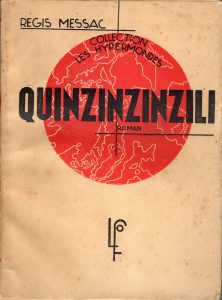 Alongside lost race fantasies, futuristic science fiction is another obvious vehicle for literary forays into historical linguistics. Régis Messac’s Quinzinzinzili from 1935 is a particularly interesting variant, being – as far as I know – the only serious fictional treatment of contact linguistics. (Admittedly I haven’t looked elsewhere.) Set in the period after a fictional World War II which everybody in this interwar period seemed to be expecting anyway), its narrator is trapped in a post-apocalyptic world alone with a particularly annoying handful of pre-teens. (And thus probably the most gruesome post-apocalyptic story ever written.) They are largely French speakers, but there are Portuguese speakers and English speakers among them as well. They develop a sort of pidginized French, colored by a spontaneous sound changes such as the nasalization of all vowels, along with curious semantic shifts. The title Quinzinzinzili reflects this all, being their rendition of the second clause in the Lord’s Prayer in Latin (qui es in cœlis ‘who art in Heaven’), used as a name for their inchoate deity. I won’t say any more because I think everybody should read it. Way better than Lord of the Flies, which it preceded and superficially resembles. (And which has no noteworthy linguistic content.)
Alongside lost race fantasies, futuristic science fiction is another obvious vehicle for literary forays into historical linguistics. Régis Messac’s Quinzinzinzili from 1935 is a particularly interesting variant, being – as far as I know – the only serious fictional treatment of contact linguistics. (Admittedly I haven’t looked elsewhere.) Set in the period after a fictional World War II which everybody in this interwar period seemed to be expecting anyway), its narrator is trapped in a post-apocalyptic world alone with a particularly annoying handful of pre-teens. (And thus probably the most gruesome post-apocalyptic story ever written.) They are largely French speakers, but there are Portuguese speakers and English speakers among them as well. They develop a sort of pidginized French, colored by a spontaneous sound changes such as the nasalization of all vowels, along with curious semantic shifts. The title Quinzinzinzili reflects this all, being their rendition of the second clause in the Lord’s Prayer in Latin (qui es in cœlis ‘who art in Heaven’), used as a name for their inchoate deity. I won’t say any more because I think everybody should read it. Way better than Lord of the Flies, which it preceded and superficially resembles. (And which has no noteworthy linguistic content.)
And if anybody knows a good source for back issues of New York Boys’ Weekly, our lines are open.
One thought on “Adventures in Historical Linguistics”
Interesting and fair about “Quinzinzinzili” of Régis Messac. Luckily for the Anglo-Saxon reader, “Quinzinzinzili” is now available in English in an excellent translation of Mathieu Triay, under the title “Quinzinzinzany”, for the magazine “Visions”.
https://www.readvisions.com/